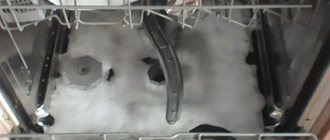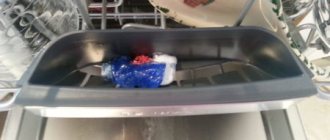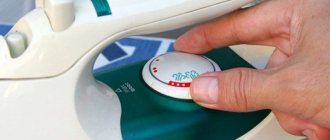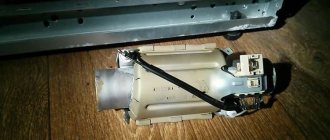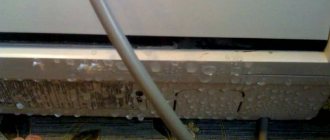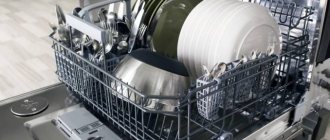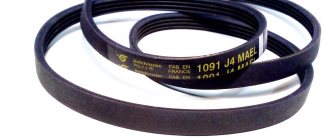Main device of the dishwasher
If you want to know how an Indesit, Bosch, Electrolux or dishwasher from any other brand works, be sure to read the material to the end. Let's start with the most important thing - the heart of the device. It is a powerful motor, sometimes called a circulation pump.
. It circulates water with detergent or rinse aid, taking it from the working chamber and returning it through the rocker arms. As for the rocker arms, they serve as rotating spray nozzles.
The largest element in a dishwasher is the working chamber. It is in it that the rocker arms are located, playing the role of washing elements. There are also baskets where dishes are placed. Baskets can be adjusted in height, and some manufacturers provide them with a transformable design, which makes it easier to store kitchen utensils of non-standard sizes.
- Filter – provides filtration and removal of solid contaminants (food residues);
- Drain pump (also known as drain pump) – removes dirty water outside the dishwasher;
- Drain hose - its purpose is clear without any comment;
- Aquastop - it is not present in all dishwashers, but it allows you to protect against leaks. The executive element of this unit is a solenoid valve located at the very end of the inlet hose.
Also in the device of any dishwasher there is the following combination:
- Inlet hose - it is connected to the water supply system, through which cold water flows into the device (or hot water, if someone connected the equipment to a hot water supply pipe);
- Solenoid valve - participates in filling water, shutting off or opening its supply;
- Water heater - classic or instantaneous. The latter helps reduce cycle times by heating water instantly rather than gradually.
Please note that in front of the inlet hose there is a simple coarse filter in the form of a metal mesh
. It plays an important role in the design of a household dishwasher, filtering out large contaminants that can enter the dishwasher from the water pipe.
As we can see, the design of dishwashers is extremely complicated. And all this despite the fact that we have not yet touched on a number of important organs, nodes and systems. Ion exchanger is a very important part responsible for water softening
. The thing is that salts dissolved in hard water interfere with normal washing. The exchanger, which operates on the basis of a special ion exchange resin, allows you to replace magnesium and calcium ions with sodium ions, resulting in softer water.
A container is installed in conjunction with the ion exchanger, into which salt or substances replacing salt are poured - they help restore the amount of sodium ions in the ion exchange resin. Salt is taken from here automatically, its amount depends on the settings in the dishwasher. The container holds approximately 1 kg of special salt for dishwashers.
In addition to all this, dishwashers contain pressure switches (water level sensors), thermostats (determine the temperature of the washing mixture), and various touch sensors (in machines with automatic programs). Water inlets for collecting water are also installed here, and there are numerous connecting hoses and clamps. The whole thing is wrapped in a body with effective noise insulation.
We forgot to mention the most important detail in the internal structure of any dishwasher - this is the control board, which is the “brain” for all the filling.
. It is from this that the wires go to the sensors and various electrical modules. A control module works in conjunction with the board, on which knobs, buttons, indicators and other elements are located.
Older dishwashers had mechanical control modules. They are not used in modern technology - their device is based on electronics.
What to do if the dishwasher is still under warranty
For at least the first year after purchase, do not repair it yourself - by doing so, you will deprive yourself of warranty benefits. The warranty period and conditions must be clarified when purchasing household appliances.
If you use detergents that are not intended for dishwashers to wash dishes, warranty repairs may be denied.
During this period, you can work to remove blockages in the dishwasher filters. In addition, it is allowed to clean the holes in the sprinkler rocker arms from dirt and food debris if the PMM begins to wash dishes poorly.
Do not forget that many defects in work occur due to non-compliance with operating rules. The machine may not work only because there is no water in the water supply or someone has closed the inlet ball valve.
Modern authorized service centers have all the necessary tools and spare parts for warranty repairs
Therefore, you need to periodically check: the presence of electricity in the sockets, the water pressure in the water supply and the absence of blockages in the sewer. If you connect the dishwasher to the communications yourself, make sure you did everything correctly. An error may result in the PMM refusing to wash dishes.
Do not take warranty equipment for repair yourself; the store should arrange delivery
Remember: you do not need to take the PMM yourself for repairs to a service center under warranty. This must be done by the store that sold you this equipment, because it weighs more than 5 kg. It is quite possible that technicians will volunteer to repair the device at home.
Basic malfunctions and their elimination
Next, we list the most common defects and tell you how you can eliminate them by doing the repairs yourself. Many of them are associated with external factors, for example, low water pressure in pipes or insufficient voltage in the electrical network. Many malfunctions are associated with blockages in the drainage or drainage system of the PMM. This kind of problem is quite easy to fix on your own.
Dishwasher won't turn on
If such an event occurs, the first thing that comes to mind is that there is no supply voltage . This can happen for various reasons:
- the power cord is not plugged into the outlet or is damaged;
- no contact in the 220 V socket;
- the PMM input network filter has failed;
- The electronic control unit (hereinafter also referred to as ECU) is damaged.
A multimeter is a device that helps check the presence of supply voltage
In order to perform diagnostics and check the presence of supply voltage, the user will need a multimeter (hereinafter also referred to as a tester). This device is universal and can be used in the household for various equipment problems.
Damage to the power cord can lead not only to the shutdown of the PMM, but also to a fire.
The tester will allow you to determine whether there is voltage in the socket, and also check the wiring inside the PMM housing for a break. The surge protector may burn out due to excess voltage in the electrical network. A sign of damage is the presence of burnt elements.
In addition to the filter, a starting capacitor installed on the drain pump can prevent the dishwasher from turning on. The serviceability of the capacitor can also be checked with a multimeter by measuring its resistance. Damaged parts must be replaced with strictly similar ones: you should not experiment with the capacitance and permissible voltage of capacitors.
Damage to the ECU is less likely; such a breakdown is complex and requires qualified intervention. In addition to the above reasons, the source of the problem may be the lack of water in the water supply and the door not being closed until it clicks - in these cases, the operating program does not start.
The dishwasher is leaking
Water leakage in the bottom of the PMM is a fairly common malfunction that can lead to flooding of the room. Therefore, recently, almost all manufacturers have equipped their dishwashers with Aquastop protective systems (hereinafter also referred to as “Aquastop”).
Float and sensor of the Aquastop system located in the bottom of the dishwasher
When water penetrates the bottom of the PMM, it lifts the polystyrene float. He begins to put pressure on the sensor, which triggers and sends a signal to shut off the water. The machine stops working, the liquid at the inlet is blocked by a solenoid valve built into the inlet hose. At the same time, the drain pump starts, which pumps water out of the dishwasher. The display shows an error code, which makes it easy to identify the malfunction.
Aquastop solenoid valve at the inlet hose
There can be several reasons for a leak:
- During installation, the dishwasher was not leveled, so the water overflows over the edge of the tank;
- due to poor-quality detergent or its overdose, excessive foaming is observed;
- the water level sensor (hereinafter also referred to as the pressure switch) is faulty, causing the machine to draw too much liquid;
- the seal of the door is broken due to loss of elasticity of the seal or its loose fit to the body;
- The Aquastop system sensor is faulty or the float is stuck.
Eliminating the above problems, with the exception of replacing the pressure switch and the sensor with a float, is quite simple. The condition of the door and excessive foaming are visible to the naked eye; setting the PMM level is also not difficult. In these cases, it is enough to eliminate the cause, remove the water from the pan, dry the machine, and it will be ready for use again.
In addition to the reasons listed, there is a possibility of a leak in the connection of one of the pipes located in the machine body. Read more about leaks and their elimination here.
From this video, readers can learn what to do if your dishwasher is leaking:
Water does not drain
In this case, you can also fix the dishwasher yourself. Problems with the drainage system can occur for several reasons:
- there is a blockage in the drain hose or it is simply pinched;
- sewer clogged;
- the filter element is clogged because it has not been cleaned for a long time;
- The drain pump does not work.
Owners can solve problems with sewerage themselves or call plumbers for this. The filter must be removed and washed thoroughly in warm water and dishwashing detergent to remove grease from the fine mesh.
Removing the filter from its slot for cleaning
You can check the drain pump impeller for free rotation without disassembling the machine body. Access to it will open if you unscrew the hexagon socket screw (TORX) in the glass under the filter and remove the protective cap. You can then check the rotation with your fingers and remove the foreign object with tweezers if it is interfering with the pump.
Disconnecting the drain hose from the diagnostic pump
To diagnose the drain hose for blockages, you will have to disassemble the dishwasher body to get to its bottom. Otherwise, it cannot be separated from the drain pump. Read more about problems with drainage in PMM here. In addition, readers can watch a video that answers the question of how to unblock the drain pump of a Bosch dishwasher:
Water flows poorly or does not flow at all
This kind of defect is associated with insufficient water pressure or clogging in the PMM inlet filters. The malfunction may be accompanied by poor rinsing. To troubleshoot malfunctions, remove and clean the strainers at the inlet hose inlet and at its connection to the dishwasher body.
Coarse filter in the inlet fitting of the dishwasher housing
The Aquastop solenoid valve at the inlet hose may be faulty. To determine serviceability, it is enough to check the resistance of its winding with a multimeter. If the device shows an open circuit, the valve must be replaced. A working valve should have a resistance of 1.5 to 5 kOhm.
In addition, the intake valve in the PMM itself, which is controlled by the ECU, may fail. Also, the cause of poor fluid collection may be improper operation of the pressure switch, giving incorrect readings about its level.
Filter at the inlet of the Aquastop solenoid valve
From this video, readers will learn how to find out the reason for the lack of water supply:
Poor dishwashing quality
In this case, you need to pay attention to whether you are operating the dishwasher correctly. Most often, it is this factor that affects the quality of washing kitchen utensils. For example, not enough washing gel or powder is loaded, dishes are not placed in baskets correctly.
Incorrect placement of dishes is one of the main reasons for poor washing quality
Another probable reason is the formation of scale on the electric water heater. As a result, the liquid does not heat up to the required temperature, which prevents the proper cleaning of kitchen equipment from dirt and food debris. How to clean PMM and its parts from scale, read here.
The nozzles in the sprinkler rocker arms must be cleaned regularly
Another probable reason for poor washing is contamination of the holes in the rocker arms of the sprayers (nozzles). To clean them, you need to remove the lower and upper sprinklers from the chamber and clean their holes with a toothpick, picking out the dirt out.
In many cases, you can diagnose and repair a dishwasher yourself. It is worth calling a specialist in difficult situations when your own strength has been exhausted. Readers can find more detailed information about all common PMM malfunctions on our website.
Possible equipment diseases
Some users who have absolutely no understanding of the complexities of household appliances call service centers for every little thing. But many problems can be solved on your own:
- water does not enter the unit;
- water does not drain;
- The product freezes when turned on.
In the above cases, you can try to revive the equipment yourself. First, check whether the water supply tap is open, then check whether the door is closed tightly, inspect the outlet, maybe the reason is its malfunction. Water may not drain due to clogged filters or connection pipes in the drainage system. If everything is in order there, you need a wizard to diagnose all nodes.
Watch a video on cleaning equipment:
Couldn't fix your machine by cleaning? Then diagnose the pump. The node is located at the bottom of the body. If there is a problem, just disconnect the wiring of the part, turn it and remove it from its place. After this, a new node is installed.
Heating fault
The first sign of heating problems is poor dishwashing. Fat does not dissolve in cold water, so you will remove wet but dirty utensils from the chamber. Diagnostics will help to accurately determine the cause of the problem. You need to check:
- A heating element;
- Temperature sensor;
- Their wiring and control triacs on the board.
Replacing the heating element in Electrolux PMM models is complicated by the presence of a non-separable heating block. Buying a replacement part will cost 3000-4000 rubles. Think about whether the game is worth the candle. If the equipment is already old, it makes sense to add money to a new dishwasher rather than buy a unit.
Have you decided to make a replacement? Then here is the sequence of steps for disassembling the PMM:
- Unplug the machine;
- Shut off the water supply and disconnect communications;
- Remove the baskets from the hopper;
- Remove the filter and water at the bottom;
- Unscrew the five screws securing the heater;
- Turn the body on its side;
- Remove the bottom;
- The block is connected to a circulation pump;
- Turn off the wiring, release the clamps;
- Rotate the block and disconnect it from the pump;
- Install the new unit in reverse order.
To avoid problems with network outages, connect a voltage stabilizer.
Problems with washing are possible when:
- poor supply of detergents;
- overloading the machine with dishes;
- blocking the sprayer;
- circulation pump malfunction.
Check the powder supply simply. Open the cuvette - if the remains of the tablet are visible in it, it means that water is not entering the compartment well. Check the placement of dishes in the hopper. Maybe a large plate is blocking the compartment, or the supply hose is clogged. Clean the cuvette after each wash to prevent detergent from accumulating in it.
Overload interferes with fluid circulation. When one device overlaps another, water does not wash the surface. There must be a gap between the plates for high-quality washing.
The rotation of the rocker arm, again, can be blocked by the plate. There may be a blockage or foreign object in the way. Clean the sprayer holes - nozzles.
After this, the pump is inspected. If it breaks and does not pass liquid, the unit needs to be replaced. The case will need to be disassembled. Remove the bottom, disconnect the pipes leading to the pump. An example of the repair is shown in the video:
Leak in the system
Damage or corrosion of the unit body leads to leakage. Although this is rare, it is not recommended to do any soldering yourself. Such repairs will not last long, so you will have to completely replace the body.
When Aquastop is activated, water may end up in the sump or leak from the hose connections. Inspect the following items:
- Hose fastenings. Tighten the clamps tighter.
- Pump gasket. If worn, install a new element.
- Door seal. Loss of tightness leads to leakage. Open the door, remove the old seal and install the new one.
Check to see if the pallet is damaged. Then it’s better to put a whole stand. If the float sensor malfunctions, a working part is installed.
PMM does not work, does not turn on
The program stops in the middle of the cycle, the dishwasher is plugged in, but does not respond to pressure. These are the main signs of problems with electronics. Try rebooting the system. Did not help? Then check:
- Condition of the cable and plug;
- Sockets;
- Capacitor.
After the inspection, the control board is diagnosed. Sometimes there is no point in changing a module, since it is expensive. Contact a specialist - he will tell you whether it is possible to repair the board.
Most problems can be fixed with your own hands. But some of them require contacting a service center. Follow the operating rules, and then you will not cause your equipment to break down.
What to do if there is no indication in the dishwasher and it does not start
If your dishwasher does not react at all when turned on (even the power indicator does not light up), check first:
- Availability of electricity. Perhaps the outlet is faulty, the dishwasher has been knocked out, or there is no electricity in the entire house.
- The dishwasher's power plug and cord are in good working order. Inspect the dishwasher's power cord and plug. Before unplugging it from the socket, for safety reasons, it is recommended to turn off the electricity in the apartment at the switchboard. If you notice damage, leave the equipment unplugged and call a professional.
If everything is normal with the power supply to the dishwasher, most likely the cause is a breakdown.
Troubleshooting tips
For any type of breakdown, it is important to carry out the most accurate diagnosis. Often, the participation of a master is not necessary. Using the dishwasher operating instructions, you can carry out this procedure yourself. For example, if the equipment cannot be turned on, the Bosch dishwasher repair instructions suggest first checking the voltage level in the network.
A guide to troubleshooting other device malfunctions from the manufacturer Bosch suggests:
- visual inspection of the device;
- identifying the presence of deformation of the power cord;
- checking the correct connection of the water drain and its supply hose.
Sometimes repairing a Bosch dishwasher at home on your own is impossible without partially disassembling the equipment. For example, the SRV55TO3EU model requires mandatory testing of the functioning of internal components, including valve sensors and pumps.
DIY dishwasher repair
As you understand, frequent causes of breakdowns are blockages or incorrect connections. Let's look at how to carry out repairs yourself, without the help of a specialist.
Getting ready for disassembly
In a Bosch dishwasher, as in machines of other brands, all the most important parts are located in its lower part. At first glance, it seems that there is nothing difficult in turning the car upside down, removing the pan and gaining access to everything that is required. In fact, in practice everything looks a little more complicated, but more on that later, first, preparation.
In any business, preparation is the basis of all work; approximately half of all failures are the result of a poorly prepared workplace, tools and materials, as well as a lack of necessary information. To avoid getting into trouble, let's start preparing the workplace. Naturally, few people have a full-fledged workshop at home; if you have one, good; if not, it doesn’t matter either. Do the following.
- Slide the Bosch, Siemens (or other brand) dishwasher out of the niche in the kitchen unit, then turn off the water supply and unplug the power cord.
- Disconnect the inlet hose as well as the sewer hose.
- In a convenient place for work, spread cellophane, a few rags on top, and place the dishwasher on them.
Note! Some people find it more convenient to disassemble the Bosch dishwasher in the bathroom so that water leaking from the machine does not flood the floor. If you have a spacious bathroom, you can try this trick.
The “dishwasher” is ready for disassembly. Now let's prepare the tool. Let us note right away that the dishwasher can be disassembled with almost bare hands, the maximum that we need is this:
- Phillips and flat head screwdriver;
- pliers;
- thin awl.
Do-it-yourself repair and maintenance of a BOSCH dishwasher.
It’s good when household appliances in the house work in such a way that you don’t even notice them. We get used to good things quickly. Just a little over 10 years ago, dishes were washed by hand, but dishwashers came along and life in the kitchen at home has really changed. Just know, take out the clean one, put in the dirty one and press the button. And just when the owner unconsciously perceives his dishwasher as something eternal - oops! Without washing the dishes, the machine stopped... The dishwasher gives us the first surprise. Yes, unfortunately, nothing lasts forever... And, nevertheless, I would say that the old BOSCH SGS57M12EU dishwasher can proudly stand on the pedestal of the most reliable household appliances. Without exaggeration, it was an excellent car ten years ago and, like most good things, it has not lost its consumer appeal to this day. So, after more than 10 years, the car stopped. It looks like the device is finishing its journey along a straight section of the reliability curve and is approaching the part where a sharp decline inevitably occurs... Is there anything else that can be done to extend the life of your dishwasher? This is the case here. Of course, it is always better to replace the device with a new one, rather than waste time and energy patching holes in the old one. However, we are not always able to do the right thing. Sometimes you need to somehow trample for a while without noticeable costs. What can you do yourself and without significant costs, and is it possible to restore the operation of a failed dishwasher? The answer is yes. As a rule, for a good-quality dishwasher from BOSCH, its first failure is not a reason to throw away an expensive (especially now) device. What can you check for yourself? A video will tell you about this much easier and more clearly than regular text. Often the machine stops due to a failure of the pump located directly behind the filter system. The impeller of this pump often turns out to be simply clogged with something hard, or a cherry pit or the like gets in there... At the same time, the machine stops working. Correcting the situation and cleaning the impeller is a matter of minutes. For details on what and how to remove and disassemble in order to clean the impeller yourself, watch the Domorost video, dedicated to self-service of a BOSCH dishwasher
We get used to good things quickly. Just a little over 10 years ago, dishes were washed by hand, but dishwashers came along and life in the kitchen at home has really changed. Just know, take out the clean one, put in the dirty one and press the button. And just when the owner unconsciously perceives his dishwasher as something eternal - oops! Without washing the dishes, the machine stopped... The dishwasher gives us the first surprise. Yes, unfortunately, nothing lasts forever... And, nevertheless, I would say that the old BOSCH SGS57M12EU dishwasher can proudly stand on the pedestal of the most reliable household appliances. Without exaggeration, it was an excellent car ten years ago and, like most good things, it has not lost its consumer appeal to this day. So, after more than 10 years, the car stopped. It looks like the device is finishing its journey along a straight section of the reliability curve and is approaching the part where a sharp decline inevitably occurs... Is there anything else that can be done to extend the life of your dishwasher? This is the case here. Of course, it is always better to replace the device with a new one, rather than waste time and energy patching holes in the old one. However, we are not always able to do the right thing. Sometimes you need to somehow trample for a while without noticeable costs. What can you do yourself and without significant costs, and is it possible to restore the operation of a failed dishwasher? The answer is yes. As a rule, for a good-quality dishwasher from BOSCH, its first failure is not a reason to throw away an expensive (especially now) device. What can you check for yourself? A video will tell you about this much easier and more clearly than regular text. Often the machine stops due to a failure of the pump located directly behind the filter system. The impeller of this pump often turns out to be simply clogged with something hard, or a cherry pit or the like gets in there... At the same time, the machine stops working. Correcting the situation and cleaning the impeller is a matter of minutes. For details on what and how to remove and disassemble in order to clean the impeller yourself, watch the Domorost video, dedicated to self-service of a BOSCH dishwasher
Often the machine starts to wash dishes very poorly. Surely the problem is that the water supply holes are overgrown with limestone deposits or clogged with dirt. For details on what and how to remove and disassemble in order to clean the water supply holes yourself, watch the Domorost video, dedicated to self-service of a BOSCH dishwasher
Sometimes the machine stops drawing water due to contamination of the mesh filter of the AquaStop system. Unscrew the aquastop system hose from the water pipe
and clean its strainer.
A heavily contaminated mesh filter may well be the reason for stopping the water supply to the machine.
A hose with an aquastop system is very reliable, but if it fails, it is quite possible to replace it yourself without calling any specialists. For details on what and how to remove and disassemble in order to replace the aquastop system hose yourself, watch the Domorost video, dedicated to self-service of a BOSCH dishwasher
However, the term complete protection against leaks provides for the joint operation of a system of several nodes. The Aquastop system hose is only one of the elements of the entire system of complete protection against leaks.
Another element of the complete leakage protection system is the float switch block. The float itself is located in the pan of the washing machine and if water somehow gets into the pan in an abnormal way (the machine is leaking), then the floating float pushes the switch button through the rocker arm and rod and it blocks the water supply through the hose of the aquastop system. So, over time, the entire mechanics of this entire system may well simply become “overgrown with dirt” and stick in a position that turns off your car. For details on how to clean all these mechanical components and parts of your dishwasher yourself and save a very tidy sum, watch the video Domorost, dedicated to self-service of a BOSCH dishwasher
Sometimes the control system “brains” of the dishwasher fails. How to independently check the control system board and make a rough diagnosis of its performance - and about this, too, watch the Domorost video, dedicated to self-service of a BOSCH dishwasher
In addition, in the Domorost video, dedicated to self-service of a BOSCH dishwasher, it will tell you what to look for when choosing a new dishwasher and will remind you of those simple basic operations that need to be carried out regularly - washing filters and adding salt.
I hope that after watching the video, every happy owner of a BOSCH dishwasher who can hold a screwdriver in his hands will be able to easily carry out the initial inspection and maintenance of his machine. I am sure that in the vast majority of cases such inspection and maintenance will return the failed device to service and it will still serve you, despite its advanced age 
